Rachel Neumeier's Blog, page 291
September 22, 2016
How do you like the term “noblebright”?
So, a term I’ve seen around recently, which is supposed to be the antonym for “Grimdark,” is “Noblebright.” What do you all think about that? I like it, more or less, though it sounds like the sort of term that would be applied mainly to a subset of high fantasy rather than across SFF subgenres.
How would you define it? Apparently it’s been around in roleplaying game circles for a while: An Urban Dictionary entry from 2010 reads: used to describe roleplaying settings, noblebright is the opposite of grimdark, used to describe settings where noble heroes valiantly fight against evil forces to create a brighter future. That sounds like a fine definition to me. I think you do need both elements: the protagonist needn’t be one-dimensional and certainly shouldn’t be artificially saccharine, but he or she ought to be fundamentally “noble.” Which definitely includes “striving for a better future.” I think that’s a very important element.
Also important: the quest toward a brighter future has to be successful. The world must be objectively better off at the end of the story than it was at the beginning. I think that’s also crucial for anything that’s supposed to be an antonym for grimdark.
The protagonist should be a better person at the end, too: stronger or more morally confident or something of the kind — the opposite of (say) Abercrombe’s FIRST LAW trilogy, where the guy who becomes in the end a puppet king was striving to become a better person but instead becomes weaker; or even more so in the related BEST SERVED COLD, which is the one that solidified my own vehement dislike of grimdark. Heroism goes nowhere in grimdark; that’s part of the definition. THE GASLIGHT DOGS had the same kind of character arc for one of its protagonists; he started off weak and ended up evil. UGH.
So, what would be some examples of noblebright fiction, if you defined the category by example? I’m looking specifically for fiction, not games or movies.
I mean, lots of stuff is “not grimdark” but also does not strike me as fitting into any possible “noblebright” category.
Take Scott Lynch’s LIES OF LOCKE LAMORA series, say.
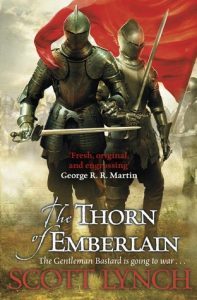
Why it’s not grimdark: It’s just not. It doesn’t have that world-going-unavoidably-to-ruin hopelessness.
Why it’s not noblebright: the main characters are in it for themselves — they’re not striving for anything but their own wealth. Also, too gritty. So, since I feel that last is a count against it in this context, obviously I would add “not too gritty” to the definition of noblebright fiction.
How about Django Wexler’s THOUSAND NAMES?
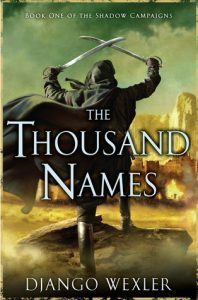
Why it’s not grimdark: It’s just not. Also, I presume the bad guys will not ultimately win (the series isn’t finished, but it doesn’t seem aimed in that direction).
Why it’s not noblebright: Winter is focused on herself and her own life. Marcus is focused on himself and his immediate surroundings. Who the heck knows what Janus bet Vhalnich has in mind? It’s impossible to be completely sure he’s even a good guy. I love these protagonists, but they don’t strike me at all as noblebright protagonists.
I like Lynch’s series; I need to read the 4th book. And I LOVE the first two books of Wexler’s series and look forward very much to starting over at the beginning and reading the whole series straight through when it’s finished. But they’re not noblebright, imo.
What is?
How about …
The Sharing Knife series. Fawn is focused mainly on herself and her small-scale concerns, but Dag is definitely focused on the broader picture.
The Chalion series. Even more so. The way the religion is handled on top of the protagonists and the basic structure of the plots makes this series definitely fall into the noblebright category.
The Goblin Emperor. Although I wish it had a sequel. But even from the first book, you can see how much better the world will be after Maia’s reign.
I started off by thinking of adult fiction, but I wonder if more YA falls into the noblebright category. Robin McKinley’s books, say. You know, The Wings of Fire series totally fits the criteria.
What do you think of the proposed category and its name? What are a couple examples you can think of — and are they MG, YA, or adult?
Please Feel Free to Share:









September 20, 2016
Best Cover for this year award winners
From Camestros Felapton, a chance to nominate and for all I know possibly vote on the best cover for any book that was nominated for the Hugo or Nebula or won the new Dragon award this year. Ooh, covers! Always happy to have strong opinions about the artistic merit and general coolness of book covers.
Unfortunately the linked post didn’t actually provide the covers — but here is a post where links are provided to the covers.
The Long Way to a Small Angry Planet – Becky Chambers (Hodder & Stoughton)
Europe at Midnight – Dave Hutchinson (Solaris)
The Book of Phoenix – Nnedi Okorafor (Hodder & Stoughton)
Arcadia – Iain Pears (Faber & Faber)
Way Down Dark – J.P. Smythe (Hodder & Stoughton)
Children of Time – Adrian Tchaikovsky (Tor)
Somewhither: A Tale of the Unwithering Realm by John C. Wright (Castalia House)
Son of the Black Sword by Larry Correia (Baen)
The Shepherd’s Crown by Terry Pratchett (Penguin) x2
Hell’s Foundations Quiver by David Weber (Tor)
League of Dragons by Naomi Novak (Del Rey)
Ctrl Alt Revolt! by Nick Cole (Amazon)
Souldancer by Brian Niemeier (Amazon)
The Fifth Season by N.K. Jemisin (Orbit)
Uprooted by Naomi Novik (Del Rey) x2
Ancillary Mercy by Ann Leckie (Orbit)
Seveneves: A Novel by Neal Stephenson (William Morrow)
The Cinder Spires: The Aeronaut’s Windlass by Jim Butcher (Roc)
Raising Caine, Charles E. Gannon (Baen)
The Grace of Kings, Ken Liu (Saga)
Barsk: The Elephants’ Graveyard, Lawrence M. Schoen (Tor)
Updraft, Fran Wilde (Tor)
War Factory, Neal Asher (2)
Envy of Angels, Matt Wallace (1)
The Watchmaker of Filigree Street, Natasha Pulley (1)
Sorcerer to the Crown, Zen Cho (3)
Half a War, Joe Abercrombie (3)
Now, imo, although a spaceship cover is fine in that it signals This Is SF, it is also just a terribly boring, genetic type of cover. So for me that takes out The Long Way and Ancillary Mercy and Children of Time. A basically monochromatic cover is generally not that appealing to me, especially if the cover is very dark (I’m sure there are exceptions), so that takes out Europe at Midnight and Somewhither. Any kind of cartoony style or any kind of stylized lettering with no scene or figures is generally not something I’d go for,so that takes out Way Down Dark.
Wow, I’m being hard to please.
Honestly, out of the whole bunch, there are plenty that I don’t think would catch my eye if they were face out on a shelf in a bookstore. Too black, too stylized, too generic, too whatever.
I guess my picks — based on nothing but personal taste– are Updraft and Uprooted.
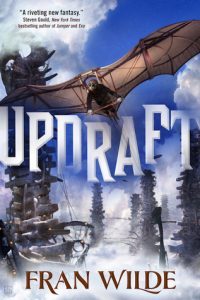
What I like: it is blue. A nice cheerful blue that catches the eye. It also tells a story, or invites the reader to wonder about the story. A kid in a hang-glider is just interesting and appealing. It suggests a world. If I saw this in a store, I would pick it up and read the back.
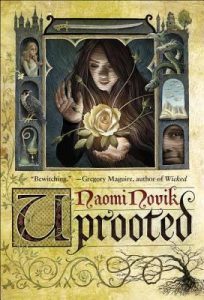
What I like: it is colorful, though yellow is not as pleasant as blue. This is a nice soft yellow, though. I like the girl and I particularly like the rose. The artistic way the tree branches turn into scrollwork is attractive and interesting and makes a nice border for that part of the image. Again, I’d read the back, even if I hadn’t ever heard of Novik.
Anyway, click through if you want and you can see what you think of all the rest of the covers.
Please Feel Free to Share:









September 19, 2016
Do teens still drive Young Adult literature?
Here’s a speech Justine Larbalestier gave at WisCon, which she posted on her website. She’s not asking the question about whether teens are driving YA; that’s my question after reading her speech. Here’s what Larbalestier says:
Most of the top-selling SFF books in the USA are YA, not adult. Many YA books sell millions of copies all over the world. Not my YA books, alas. Can’t have everything.
YA, of course, could not be this huge if only teens were reading it. The Hunger Games trilogy sold far more copies in the USA than there are teenagers. Adults are reading YA in huge numbers. Adults are making YA super profitable for publishers.
But it was teens that started the YA explosion. They were the ones who pushed the Harry Potter, then Twilight, then Hunger Games series on their parents and teachers and other adults in their lives. Pretty much every mega-hit YA book starts out that way.
This strikes me as totally true. I’m just wondering whether it’s still true today, now that YA is so popular with non-teens? Not only do lots of people my age and older enjoy YA, obviously many of the teens who pushed Harry Potter have grown up and are no longer teens, but probably lots of them still read YA. So now what age group will drive the uber-popularity of the next YA megahit series? I just wonder.
This speech is also focusing quite a bit on the societal tendency to disregard or dislike teenagers. While an interesting point, I don’t think a society-wide dislike of the young is necessarily focused on teenagers. We also see a lot of that directed at younger children.
I read an article or book once that discussed how this kind of dislike can be aimed at a particular generation, sparking a lot of “Rosemary’s Baby” kinds of movies when the generation is composed mainly of infants and then tracking that particular generation through time with movies like “Children of the Corn” and finally bad-teenager movies. Maybe that was in Straus and Howe’s GENERATIONS? Anybody happen to recall?
Anyway, Larbalestier covers a lot of ground in this speech — society’s current dislike of teenagers, the way teens today never get time to hang out without tight supervision and how that might be a factor driving them toward social media — it’s a wide-ranging speech.
I will add, I hated, HATED the set up in Larbalestier’s MAGIC AND MADNESS where using magic turned you evil, but refusing to use it made you go mad — or something like that. Some kind of dreadful catch-22. I haven’t read many other YA (or adult) fantasy novels where magic was intrinsically terrible, and it is so not my thing. Well written trilogy, though. I’d have liked it a lot if not for the background worldbuilding pertaining to magic.
Anybody read anything else by Larbalestier? What did you think?
Please Feel Free to Share:









Spectacular dinosaur fossils
Since the nineties it seems like you can’t turn around without tripping over some fabulous new dinosaur fossil, but this is pretty good even by that standard.
The Psittacosaurus specimen Vinther’s team studied is held at the Senkenberg Museum in Frankfurt. It is a complete skeleton from one of the world’s best preserved fossil deposits in China. Named the Jehol Biota, these deposits are a Lagerstätte, from the German for storage place: they are literally a rocky safehouse for the world’s most well-preserved fossils. There are a handful of Lagerstätte around the world, famed for yielding remains that retain their fossilised soft tissues, feathers, fur, skin and stomach contents. The Senckenburg Psittacosaurus is an exceptional example…

As dinosaurs go, interesting but not especially beautiful or impressive. But preserved right down to the pigments. Wow.
Biggest question, not addressed by the linked article: what the devil is that sheaf of bristles on the tail for? That is a peculiarly unimpressive idea for social display, one would think, and yet what other possible function could bristles like that serve?
Please Feel Free to Share:









September 16, 2016
Working description into your story
Over at Mad Genius Club, a quite funny example of putting description into dialogue.
This ties into the “talking heads” type of scene I linked to yesterday.
“Bill blinked from where he sat at his desk, looking across him at the red spires dotting the desert landscape outside the office window. “My writer’s group said I needed more description and sense of place,” he said. “But then when I put in description, they told me I had stopped the action and given them indigestible infodumps.”
“Ah,” Mike said. “Did you?”
“Perhaps a tadbit, but dang it all, man, how is one supposed to convey things like new technology without a ten paragraph break explaining the history and how it works?”
Also, the last lines of this scene are delightfully unexpected.

September 15, 2016
Ways not to open your story, part four
Here’s the newest installment of Kristen Nelson’s series about types of beginnings that often don’t work.
Your opening pages might be in trouble if…
#4) Your novel opens with a lengthy passage of “talking heads” dialogue.
Here’s what fascinates me: The openings we suggest that you avoid actually evolve out of a writer’s good intentions. In this case, writers know that starting with dialogue can be a very dynamic way to open a story. Dialogue is inherently more energetic than a description-of-the-setting opening, and if done well, a dialogue-heavy opening can reveal a lot about character(s).
Just so we’re clear, we’re not suggesting that you ax every bit of dialogue in your opening. The problem arises when an opening provides only dialogue to the exclusion of all other narrative elements.
We call this the “talking heads” opening. When two (or more) characters have a conversation for a page (or more), then readers receive no other vital story clues, such as setting, context, tone, background information, or the power dynamic between the characters doing the speaking
Interesting! Yes, I would think that would be hard to pull off. If anyone ever does pull it off, it seems to me it might be in a hard-boiled detective type of story. That’s not a genre I have ever read a lot, but it seems to me you often get a lot of short sentences and with a lot of dialogue, often with only a few dialogue tags. If anybody can think of a real-world example where someone pulled off this kind of talking-heads opening, let us know!
Now, if you pushed me to pick one element I think needs to be emphasized in the opening, I would go for setting almost more than anything else. The way the author handles the setting also establishes the tone, provides context, and generally contributes to characterization as well. Or so it seems to me. I always reach for Dragonsbane by Barbara Hambly to illustrate a really good story beginning that sets the protagonist (and thus the reader) firmly in the world right from the first sentences. Also, that’s just a really good book!
Good cover, too:
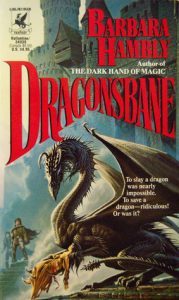

Grammar rules we don’t know that we know
Keen post here about some of the unofficial grammar rules for English that native speakers follow without thinking about it. With explanations; that’s why it’s a great post. Like this:
WHY “I CHEERED UP MY FRIEND” AND NOT “I CHEERED UP HER”
English has a group of verbs known as phrasal verbs that give language learners a major headache. These are verbs made of multiple words that together give a different meaning than you would expect by simple combination. For example blow up is a phrasal verb because it means “explode” not “blow in an upward direction.” You just have to learn what these mean. They are verbs like call off (cancel), go over (review), and put down (insult). There are hundreds of them.
Phrasal verbs do not all work according to the same rules. Some do not allow an object to come between the parts of the verb: You can say “Don’t pick on your sister” but not “Don’t pick your sister on.” But other phrasal verbs can be separated: You can say “Let’s call off the meeting” or “Let’s call the meeting off.” Native speakers know which ones are separable and which are not without ever looking at a rule book. Non-native speakers have to learn the difference through painstaking experience.
But that’s not all. Even the separable verbs have a restriction on them that native speakers never explicitly learn about. Cheer up is separable. You can say “I cheered my friend up” or “I cheered up my friend.” But if you want to substitute my friend with a pronoun, it must be placed between the parts of the verb. You cannot say “I cheered up her” only “I cheered her up.” For the inseparable verbs, pronouns are no problem: “Don’t pick on her.”
In the rest of English grammar you can substitute a pronoun anywhere you have a noun phrase. Not in this case. But you already knew that, even if you didn’t know you knew that.
Isn’t that great?
Okay, at least, if you’re the sort of person who thinks this kind of thing is great.
Definitely click through and read the whole post if that’s you.

September 14, 2016
A story checklist
Over at Black Gate, a thought-provoking post by M Harold Page on checklists and their function.
Nowadays before an operation it’s the thing for — usually — a senior nurse to work through a list with items like: “Does the patient have any allergies? Has the anaesthetist raised any concerns…? Is this even the right patient for this operation..?” There are also checklists for emergency situations such as reviving somebody fished out of a pond to make sure critical injections aren’t missed. … Why this is mildly terrifying is because (a) checklists significantly raise patient survival rates, and (b) the medical profession has only recently adopted them!
I didn’t know medical personnel did this! It makes so much sense. I’m glad they do. I hope they don’t skip it if I’m the one going under the knife! Page then goes on to mention similar checklists for pilots and then (of course) relates the concept to writing.
The whole post is worth checking out, but here are the items on Page’s checklist for a story:
1. Can the story be summed up with the following format: Question, answer, but now? Like this: “Can Frodo take the One Ring to Mordor? Yes, but its destruction heralds the end of Middle Earth as we know it. Now he and the world must cope with modernity.”
2. Does your story start with the question and end with the answer? Long-winded infodump prologues by definition start somewhere other than the question, so this would be a type of check aimed against that kind of structure. I will add that I like long epilogues (usually).
3. Do all the character choices make sense? An excellent question, to be sure. I would say there are two main ways a story can fail this test: a) the protagonist acts out of character; and b) the protagonist does something unbelievably stupid (emphasis on “unbelievable”). At least, those are things that kick me personally out of a story if I’m reading happily along.
4. Is the exposition timely? I would phrase this: Is the reader ever confused, and if so how long does that last? I think readers are willing to wait for explanations and tolerate puzzlement, but probably not forever.
5. Is the pacing right?
6. Do the transitions work?
Not terrible as a checklist goes. I think (1) is probably helpful for coming up with back cover copy or (worse) two-sentence elevator pitches. And I don’t dislike all prologues, but I think the writer should probably consider carefully whether a prologue is adding value or not. Epilogues too, though as I say I usually like epilogues (much more often than prologues).
First readers can help with that “Do character actions make sense” thing. It can be truly difficult to tell, or at least I find myself uncertain about that exact issue more than many others. Same with pacing, in fact. Actually I’d say 3 through 6 are reasons to have an analytical beta reader check over completed work before you open your hands to let the stories fly.
Click through to read the more extensive comments about each item. There are two more items, but they’re not really about evaluating the story, so I left them out here.

On subverting prophecies and The Chosen One
I’m not saying I can’t enjoy a book with a prophecy, just that it seems a) rather overdone, and b) kinda predestination-ish, and I have trouble on both grounds. Also books with prophecies lean heavily toward The Chosen One trope, which is objectionable because really, the message that you can only achieve great things if you are Born Special is pretty limiting.
On that topic, remember when Cordelia told someone … Mark, maybe? … that since people aren’t perfect, it follows that all great deeds are accomplished by imperfect people, so not being flawless doesn’t excuse you from trying to achieve great things. Something like that. She was a lot more pithy and succinct, I’m sure. But that philosophy is about the opposite of The Chosen One, right?
So of course I was thinking about this because of The Wings of Fire series by Tui Sutherland and the way she drove a stake through the heart of the prophecy trope. And then I ran into this post over at By Singing Light: Not the Chosen One
At this point, the Chosen One trope has become both a huge cultural force and almost a parody of itself.
So true! Anyway, Maureen then highlights a handful of titles where the author is doing interesting things with The Chosen One trope. Of which I’ve read only, oh, call it one and a half (I loved NIMONA, but must admit I really didn’t get into Un Lun Dun).
But check out the post! I have several of these on my TBR pile, and all of them shuffled a bit closer to the top because I enjoy it when an author subverts The Chosen One idea.

September 12, 2016
Woe is me
You know, usually when adding a lot of new words to a manuscript, I save the document to a flash drive every time I’m going to close the file, and I change flash drives every couple of days. And nothing ever goes wrong.
When revising, I’m more casual; I save every couple of days or any time I make substantial changes (like adding a new scene, say). I don’t bother saving so often if I’m just doing a line-by-line cut or something relatively trivial. In that case I may not save the document to a flash drive for a day or so because it would just not be that much trouble to redo the work. And I may not switch flash drives as often either. Toward the end of the week I’ll toss the one I’ve been using in the basket where such things go and pick up a different one.
Well, I bet you can see this coming, can’t you?
I really got into the current revision last Sunday (the 4th). And yesterday, after I wrote a new scene, I saved the file. Which turned out, when I went to re-open it, to be corrupted.
If I hadn’t saved the file, I’d have been fine. But the file I saved was … yes … the corrupted file.
I tried to use a text recovery program just now. And if all I cared about was recovering the file, success! But I lost practically all the paragraph formatting. It’s just hopeless trying to use that.
I’m guessing it would take more hours trying to get the file fixed somehow than it will just to start over. Especially since I spent half an hour last night taking quick notes on what I’d done. I’m guessing three, four days. Work days, so maybe a few more, unless we get dreadful weather that prevents me from taking the dogs out (that always speeds up writing).
Anyway: ugh. So aggravating.
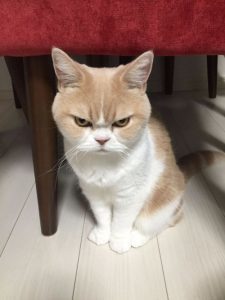
And I guess maybe I’ll start changing flash drives every. single. day.
Update: My computer-genius brother excised the corrupted portion of the file, which was most of it — but he did recover the first 75 pages. Which is 75 pages I don’t have to go back through and will surely save at least a day. So yay!




